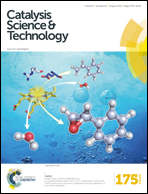The effect of an Fe promoter on Cu/SiO2 catalysts for improving their catalytic activity and stability in the water-gas shift reaction
Abstract
In this study, the water-gas shift (WGS) reaction is investigated over Cu/SiO2 catalysts with and without an iron promoter. By adding a small amount of iron, the catalytic activity and stability of Cu/SiO2 are effectively improved. The oxidation of Cu/SiO2 catalysts is considered to be the major factor for the deactivation of Cu catalysts. Fe oxides in Cu–Fe/SiO2 catalysts surprisingly inhibit the oxidation of Cu and increase the catalytic stability of Cu–Fe/SiO2 catalysts. The role of the Fe promoter in Cu/SiO2 catalysts in the WGS is thoroughly investigated using a variety of experiments, such as H2-temperature-programmed reduction (H2-TPR), IR spectroscopy, temperature-programmed desorption (TPD) and in situ X-ray absorption spectroscopy (XAS). For the Cu–Fe/SiO2 catalysts, both reactants, CO and H2O, prefer to adsorb on the defect sites on the Cu surface and on Fe oxides, respectively. The higher performance and stability of the Cu–Fe/SiO2 catalyst for the WGS reaction is explained based on the rapid dissociation of H2O on the Fe promoter.


 Please wait while we load your content...
Please wait while we load your content...